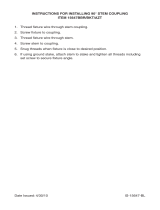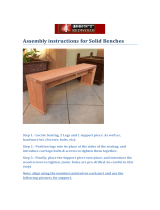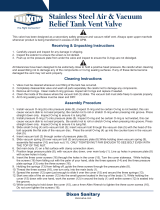
www.dft-valves.com 17 610-363-8903
PDC
®
MAINTENANCE PROCEDURES
SOFT SEATING: For valves with an
o-ring soft seat, inspect the o-ring and
replace if cracked or excessively
deformed.
7) Refacing:
A) METAL TO METAL SEATING:
A total of .03” metal per surface
has been provided on the seat and
disc to permit refacing when
necessary. It is important that the
facing remain concentric to the
axis of the parts. The finish should
be 32 Ra or better.
B) SOFT SEATING:
The disc may be refaced as
outlined above. The seat
CANNOT be refaced. If the o-ring
groove is damaged, replace the
trim. It is acceptable for the
contact surface of the seat to have
small scratches and/or pits,
provided the groove is un-
damaged.
8) Soft Seat Replacement:
A) To replace the ring, pry it out of
the groove using a thin piece of
metal (a .005" thick feeler gage
works well) taking care not to
scratch the bottom of the o-ring
groove.
B) Clean out the groove.
C) Lubricate a new o-ring with water
soluble lubricant such as
dishwashing detergent or suitable
lubricant compatible with the
process fluid.
D) To install the new o-ring, push one
section of the o-ring into the
groove with your thumb or a soft
roller, then push the section 180º
opposite from the first into the
groove. Continue by pushing in
the o-ring at points 90º to the
original sections. Finally, push the
rest of the ring into the groove.
E) Rub the o-ring in a circular motion
in the groove with your thumb to
even-out any bumps.
RE-ASSEMBLY:
1) Reinstall the check ball (or the check disc
on 10” and larger valves), spring and the
spring retainer into the disc guide.
2) Stake the outside of the spring retainer
at four (4) places to lock it in place.
3) Install new guide ring. Coat new seal
ring with general purpose lithium grease
and install on Disc Guide with the open
side of the “U” facing up toward the
compression chamber. The seal ring will
fit tightly over the Disc Guide, so be
careful not to distort it or damage its
sealing edges.
4) Seat Installation
A) DROP-IN SEAT:
i) Press bushing into body.
ii) Place spring, (large end first for
conical springs) into the body.
iii) Install the body o-ring if the valve
contains a “Full Face” seat.
iv) Apply a coating of grease to the
seal ring and guide ring.
v) Lower the disc/disc guide/seat
assembly into the body and
install the retaining screws.
B) PUNCH-PRICKED SEAT:
i) Press bushing into body.
ii) Place spring, (large end first for
conical springs) into the body.
iii) Install the body o-ring (If required).
iv) Apply a coating of grease to the
seal ring and guide ring.
v) Re-stake the O.D. of the seat with a
sharp point punch at 3 or 4 places to
create interference points, then press
the disc/disc guide/seat assembly
into the body.
5) Stroke the disc to work the valve a couple
of times to check for free disc movement.
The valve should close in the horizontal
orientation.
6) Re-install the valve in the line with the
flow arrow on the body pointing in the
direction of flow.
























